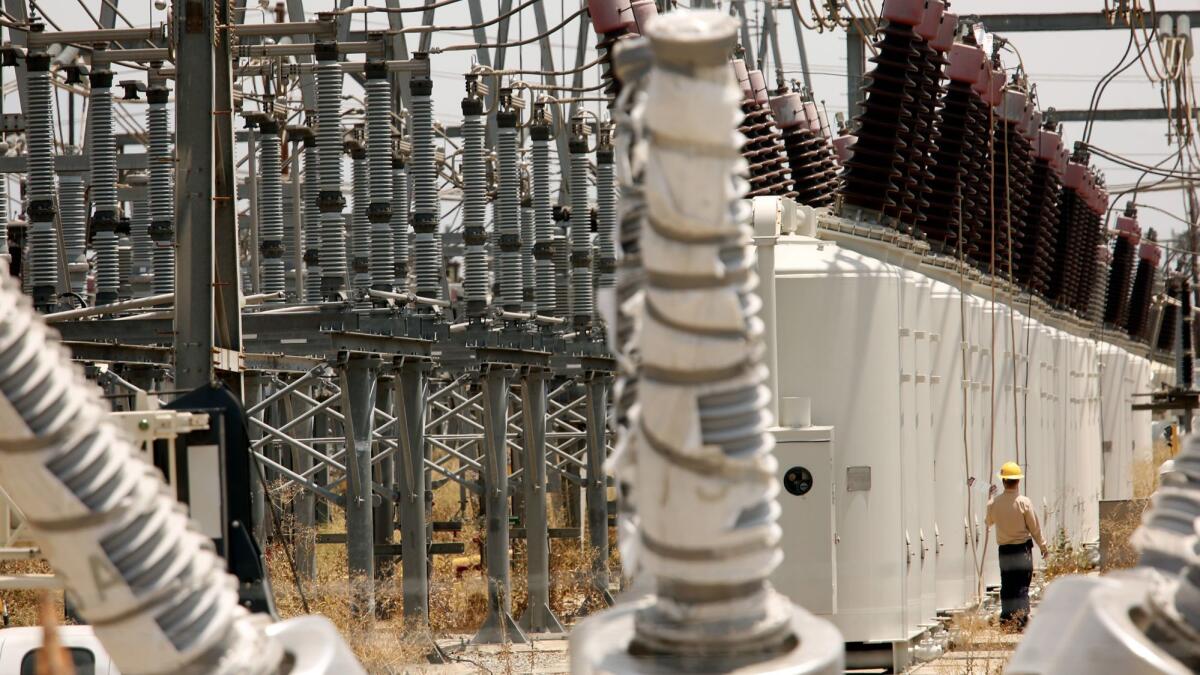Massive Valley blackout again puts spotlight on L.A.’s failing infrastructure

The explosion at a Northridge power plant that left 140,000 customers across the San Fernando Valley without electricity last weekend was a major blow to Los Angeles’ power grid.
It marked the first time in 12 years a Department of Water and Power receiving station was knocked offline. And it left a large swath of the Valley without power, in some cases for 12 hours, during one of the hottest days of the year.
On Monday, officials said the explosion was probably related to excessive energy demands due to the heat wave and was a stark reminder of the challenge Los Angeles faces in modernizing its aging electrical system.
DWP General Manager David Wright called the incident “highly unusual.” The exact cause of the blaze is under investigation, but Wright said it’s believed mineral oil being used as a cooling agent caught on fire and caused the transformer to explode.
Crippled system was in need of replacement
The size of a large truck, the high-voltage transformer that was destroyed was more than 40 years old and would have probably been replaced in the next to five to ten years, Wright said. Recent testing of the device showed no problems, he said.
As inspectors assess the damage and investigate what caused the explosion, Saturday’s incident is emblematic of the challenges facing the nation’s largest municipal utility as it plays catch-up to update its aging power grid, officials said. The blast provided another example of the city’s deteriorating infrastructure, which has made headlines after epic bursts of aging water pipes, crumbling sidewalks and gaping sinkholes.
There are 70 large transformers in the utility’s network, and 20 of them still need to be replaced at a cost of about $5 million each, officials said.
The utility’s ongoing Power System Reliability Program seeks to upgrade or replace thousands of smaller transformers, power poles, circuit breakers and other equipment.
Wright said the utility is trying “to make up for what is several decades of deferred maintenance. The concern is that we need to get ahead so that reliability increases.”

Need to rebuild aging electrical grid
A 2015 DWP report found the utility will need to “rebuild and modernize much of its aging power grid infrastructure” over the next 15 years. The same report cited research stating that eight of the utility’s 70 high-voltage transformers were past their 50-year lifespans.
L.A. faces a similar backlog for its crumbling water system. But those upgrades come with steep costs. Estimates place fixing the water system at $1.3 billion, and planned electrical fixes will cost $4.5 billion, according to the agency.
Bill Powers, a mechanical engineering consultant in San Diego, said the transformer that blew was probably near the end of its lifespan and the recent heat wave would have been akin to a “stress test.”
“Any time you are running decades-old hardware you are running more of a risk than running newer hardware,” Powers said.
Residents of an apartment complex near the DWP plant on Parthenia Street in Northridge reported hearing an explosion at the plant just before 7 p.m. Saturday, and firefighters arrived to find a gigantic vat with about 20,000 gallons of mineral oil — used as a cooling agent for electrical equipment — on fire, according to the Los Angeles Fire Department. Firefighters extinguished the flames within two hours. No one was injured.
The agency was able to restore power to all customers by 8 a.m. Sunday. DWP customers average about one outage a year for less than one hour, but “unfortunately that wasn’t these customers,” Wright said, referring to the Valley blackout.
Utility officials estimate that more than 13,000 gallons of mineral oil were released during the explosion. Water used to douse the fire carried oil into storm drains.
Power was shut off at the DWP plant to allow firefighters to fight the blaze.
The outage came at the peak of a heat wave that pushed temperatures to 100 degrees in many parts of the Valley. The agency was able to restore power to all customers by 8 a.m. Sunday.
Built in the 1950s
Receiving Station J was built in the 1950s to serve the growing industrial area in the northwest Valley, according to the Center for Land Use Interpretation. It’s one of 21 receiving stations in the DWP network that act as a bridge between power plants and local distribution. High-voltage power lines enter the grid at these stations, where the voltage is reduced and eventually sent to customers.
Climate projections show that by 2100, more than 100 days of extreme heat each year could be the norm in the San Fernando Valley, according to a 2015 UCLA study. “Extreme heat days” are those days when the temperature exceeds 95 degrees.
By comparison, most of the Valley recorded less than 50 days of extreme heat from 1981 to 2000, the study found.
More heat, more stress on system
Multiple transformers were knocked out during heat waves in 2006 and 2007, causing rolling blackouts. The agency responded by replacing hundreds of smaller transformers each year to prevent future blackouts, DWP officials said. That beefed-up infrastructure investment reduced customer outages in the following years, according to a spokesman with Mayor Eric Garcetti’s office.
DWP officials said they are preparing for future decades in which temperatures are expected to grow significantly hotter. They are working to forecast estimated demand, peak heat days and population growth. Besides infrastructure improvements, installing insulation or double-paned windows can also help the region conserve energy.
“Part of this ramping up of deferred maintenance, is that we’ve got to get ahead of this replacement cycle and be preparing for all of these extreme heat days and how we handle it,” Wright said.
ALSO
L.A. school board salaries more than double to $125,000 a year
Separating fact from hype as California begins a new fire season
‘I think it’s arson’: Developer suspects political motives as officials probe latest Bay Area fire
More to Read
Sign up for Essential California
The most important California stories and recommendations in your inbox every morning.
You may occasionally receive promotional content from the Los Angeles Times.












